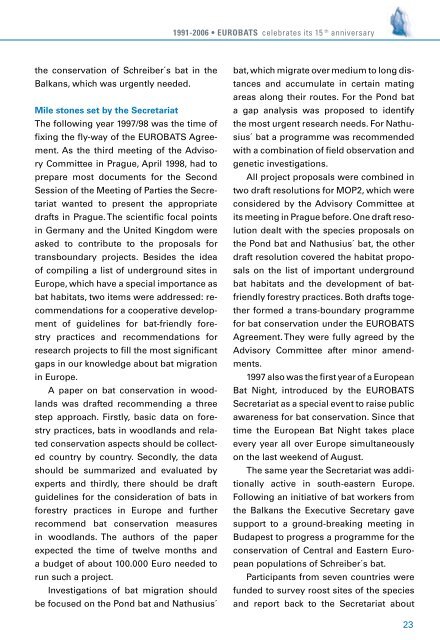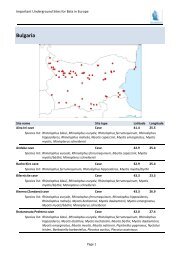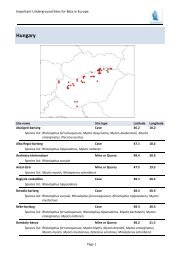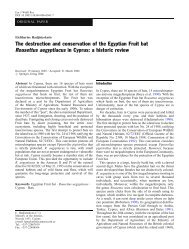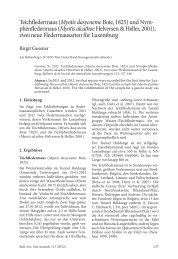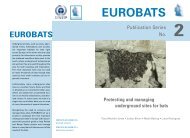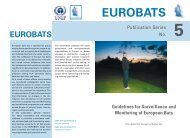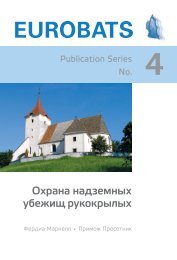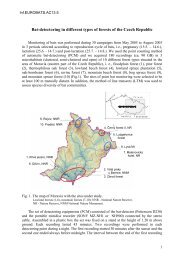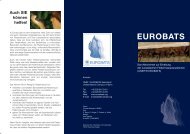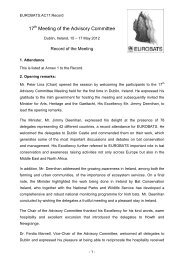1991 - 2006. EUROBATS celebrates its 15th anniversary
1991 - 2006. EUROBATS celebrates its 15th anniversary
1991 - 2006. EUROBATS celebrates its 15th anniversary
Create successful ePaper yourself
Turn your PDF publications into a flip-book with our unique Google optimized e-Paper software.
the conservation of Schreiber´s bat in the<br />
Balkans, which was urgently needed.<br />
Mile stones set by the Secretariat<br />
The following year 1997/98 was the time of<br />
fixing the fly-way of the <strong>EUROBATS</strong> Agree-<br />
ment. As the third meeting of the Adviso-<br />
ry Committee in Prague, April 1998, had to<br />
prepare most documents for the Second<br />
Session of the Meeting of Parties the Secretariat<br />
wanted to present the appropriate<br />
drafts in Prague. The scientific focal points<br />
in Germany and the United Kingdom were<br />
asked to contribute to the proposals for<br />
transboundary projects. Besides the idea<br />
of compiling a list of underground sites in<br />
Europe, which have a special importance as<br />
bat habitats, two items were addressed: recommendations<br />
for a cooperative development<br />
of guidelines for bat-friendly forestry<br />
practices and recommendations for<br />
research projects to fill the most significant<br />
gaps in our knowledge about bat migration<br />
in Europe.<br />
A paper on bat conservation in wood-<br />
lands was drafted recommending a three<br />
step approach. Firstly, basic data on fore-<br />
stry practices, bats in woodlands and rela-<br />
ted conservation aspects should be collect-<br />
ed country by country. Secondly, the data<br />
should be summarized and evaluated by<br />
experts and thirdly, there should be draft<br />
guidelines for the consideration of bats in<br />
forestry practices in Europe and further<br />
recommend bat conservation measures<br />
in woodlands. The authors of the paper<br />
expected the time of twelve months and<br />
a budget of about 100.000 Euro needed to<br />
run such a project.<br />
Investigations of bat migration should<br />
be focused on the Pond bat and Nathusius´<br />
<strong>1991</strong>-2006 • <strong>EUROBATS</strong> <strong>celebrates</strong> <strong>its</strong> 15 th <strong>anniversary</strong><br />
bat, which migrate over medium to long dis-<br />
tances and accumulate in certain mating<br />
areas along their routes. For the Pond bat<br />
a gap analysis was proposed to identify<br />
the most urgent research needs. For Nathusius´<br />
bat a programme was recommended<br />
with a combination of field observation and<br />
genetic investigations.<br />
All project proposals were combined in<br />
two draft resolutions for MOP2, which were<br />
considered by the Advisory Committee at<br />
<strong>its</strong> meeting in Prague before. One draft resolution<br />
dealt with the species proposals on<br />
the Pond bat and Nathusius´ bat, the other<br />
draft resolution covered the habitat proposals<br />
on the list of important underground<br />
bat habitats and the development of batfriendly<br />
forestry practices. Both drafts together<br />
formed a trans-boundary programme<br />
for bat conservation under the <strong>EUROBATS</strong><br />
Agreement. They were fully agreed by the<br />
Advisory Committee after minor amendments.<br />
1997 also was the first year of a European<br />
Bat Night, introduced by the <strong>EUROBATS</strong><br />
Secretariat as a special event to raise public<br />
awareness for bat conservation. Since that<br />
time the European Bat Night takes place<br />
every year all over Europe simultaneously<br />
on the last weekend of August.<br />
The same year the Secretariat was additionally<br />
active in south-eastern Europe.<br />
Following an initiative of bat workers from<br />
the Balkans the Executive Secretary gave<br />
support to a ground-breaking meeting in<br />
Budapest to progress a programme for the<br />
conservation of Central and Eastern European<br />
populations of Schreiber´s bat.<br />
Participants from seven countries were<br />
funded to survey roost sites of the species<br />
and report back to the Secretariat about<br />
23


